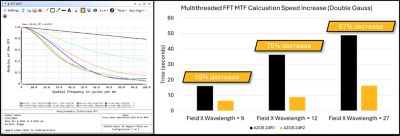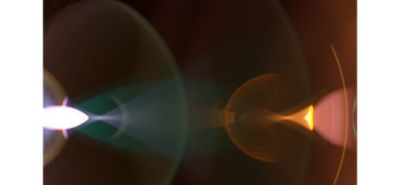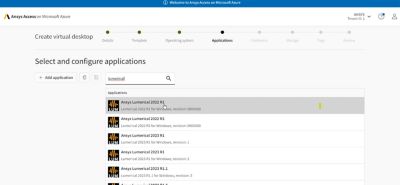Today the demand for high-quality, low-cost optical solutions is high. Designers are challenged to keep pace with performance expectations, be it for optical sensors, vehicle lighting, or co-packaged optics. In many instances, miniaturization compounds the “ask” for applications like cellphone cameras, where it’s now possible to capture a panoramic view of a breathtaking vista through a lens as small as a penny.
The introduction of freeform optics, diffractive optics, and metasurfaces to enhance these and other real-world applications adds a level of complexity in design that requires system-level engineering enabled by multiscale, multiphysics simulation. Ansys’ suite of optical solutions ensures optical engineers and designers can address real-world challenges across the wide range of industries and applications that optics are a part of — for example, to validate that an automotive lighting system meets regulatory standards, to simultaneously improve image quality while reducing the size of cellphone camera lenses, or to preview the results for virtual reality sensors that are playing an increasingly important role in guiding medical procedures.
Read on to learn more about some of the many improvements to the 2024 R2 Ansys Optics product collection and learn about the real-world impacts they are having on optical performance, manufacturing, and design: Ansys Zemax OpticStudio software for optical component design; Ansys Speos software for the design and validation of optical systems; and Ansys Lumerical (FDTD, MODE, Multiphysics, INTERCONNECT, and CML-Compiler) software for photonic, optoelectronic component design, and photonic integrated circuit system simulation.
Ansys Zemax OpticStudio Optical Design Takes Surface Analysis and Optimization to the Max
Every day, engineers and designers are looking to turn their most innovative ideas for high-precision optical systems into designs that resonate throughout the industry. In 2024 R2, OpticStudio software further enhances an already efficient, precise, and user-intuitive optical design tool to do just that with the following improvements:
- Tolerance operands for off-axis apertures and RSIs. Rotationally symmetric irregularities (RSIs) are a problem for systems with many components. New irregularity operands have been added to OpticStudio to enable accurate tolerancing for surface form tolerances 3/A(B/C), in line with the ISO-10110-5 drawing standard. These operands also automatically accommodate off-axis apertures. This feature is particularly valuable for designing freeform lenses and off-axis systems.
- Surface Slope, Surface Curvature, and Phase Slope Analysis Improvements. The improvements in surface slope, curvature, and phase slope analyses now allow users to easily analyze and constrain the maximum slope or curvature across a surface or diffractive element. A new “Modulus” data type has been introduced, which returns the maximum value of slope or curvature regardless of vector direction. This capability is also available for specific Merit Function Operands, ensuring manufacturability during optimization, such as maintaining manufacturable DOE line widths.
- Fast Fourier transform (FFT) modulation transfer function (MTF) multithreading performance improvements. Real-world design also benefits from improvements to the tools used for nominal system design. For high-precision imaging systems, the MTF is one of the key metrics for system performance. In 2024 R2, performance improvements were implemented for the FFT MTF analysis to enable more effective utilization of CPU resources for systems with multiple fields and wavelengths. Significant speed improvements have been observed while analyzing complex designs, and performance improvements increase with problem complexity, which greatly benefits modern design problems.

Fast Fourier transform (FFT) modulation transfer function (MTF) multithreading has been improved to optimize CPU resource utilization for systems with multiple fields and wavelengths
Ansys Speos Software Keeps Light From Straying Too Far
Stray light, or unwanted scattered or specular light, is an unintended consequence in optical design that degrades optical performance and image quality. It also reduces image contrast and contributes to blurring and discoloration of all camera or sensor images. In applications like handheld devices, these effects manifest as ghosts or bright spots appearing on images resulting from specular reflections between lenses, or glare caused when light scatters inside a camera. Several improvements to Speos software offer competitive advantages for designers intent on countering these effects:
- Stray light analysis gets a boost in bright spot detection and now supports more lens shapes. The tool aids optical engineers and validation designers in the identification of bright spots to quantify their direct contribution on image quality. It also helps identify corresponding optical sequences to study design modification. The addition of optical shapes improves the link between OpticStudio software and the Speos solution in consideration of overall component design.

An example of stray light analysis bright spot detection
- Light guide design better controls light distribution through multiple optical axes. A light guide is a medium used to transmit and distribute light from a source to a desired location. Varying the optical axis along the light guide through design ensures smooth variation of the light’s appearance when the observer direction is changed. It can also be used to pass regulations, such as those for side markers in automotive applications.
- The improved capabilities of the Live Preview feature enable designers to evaluate results accessible via an intuitive user-friendly interface. The tool uses new navigation modes and scaling options via management of light sources from the light panel, enabling optical engineers and validation designers to accurately view the lit and unlit appearance of their designs.
Spotlight: Automotive Lighting
Light guides are common in automotive headlamps, tail lamps, and turn indicators. One imperative for automakers is that they follow the style of the vehicle while simultaneously meeting certain requirements. Ansys delivers full capabilities to make light guide design easier.
Using the light guide feature in Ansys Speos CAD-integrated optical and lighting simulation software, optical designers can rapidly simulate and refine light guide designs, selecting different directions to extract light from light guides that achieve design and regulatory compliance via one comprehensive design workflow.
Read “Creating a Light Guide” to see how to create a light guide using Speos software.

Export to Speos data exchange improvements enable fully optical workflows
Ansys Lumerical FDTD Software Speeds Optics Verification and Sign-off
Lumerical FDTD simulation software for photonic components is for the design and optimization of a wide range of photonics components. It accounts for real-world design of modern chips through enhanced workflows with multiscale, multiphysics simulation tools. Now its integrated design environment offers even greater speed via high-performance computing (GPU/CPU) and cloud resources in one versatile, scalable solution with help from the following new tools and features:
- A new multi-GPU acceleration tool with NVIDIA A100 Tensor Core GPU improves finite-difference time-domain (FDTD) simulation speed and addresses memory bottlenecks for entire metalens and PIC simulations. It offers faster simulation and larger model memory on local or remote on-premises/cloud applications advantageous to PICs, meta surfaces, and CMOS image sensor applications.
- A new photonic integrated circuit (PIC) schematic-driven layout workflow between GDSFactory and Lumerical INTERCONNECT software enables the design and fabrication of chips, including those used in photonics, analog circuits, quantum computing, and lidar. All account for real-world design between multiscale, multiphysics simulation tools.
- A new co-packaged optics input/output workflow between Lumerical FDTD software and Zemax OpticStudio software that enables engineers to accurately account for both nano- and macro-scale optical effects in coupling in and out macro-scale optics fiber to nano-scale waveguide, using ray tracing and Ansys Maxwell software’s equation-based simulation tools. Designers can address challenges around the grating coupler, the edge coupler, and fiber optics coupling, as well as robustness analysis and tolerancing against misalignment and manufacturing variations.

Ansys Lumerical FDTD is available for GPU acceleration on Ansys Access on Microsoft Azure
Users can also run all Lumerical products on the Ansys Access on Microsoft Azure cloud engineering solution for the GPU acceleration necessary to do larger parameter sweeps for optical input/output (I/O) verification and signoff. Teams can configure a virtual desktop (Linux or Windows OS) with their own Azure subscription and map their local disk drives/Microsoft OneDrive to share project files. Then they can create a virtual desktop with access to the full Lumerical suite and Azure hardware scalability.
We’ve touched on just a few of the improvements relevant to R2 2024 Ansys Optics software that are impacting real-world optical application performance. Make sure to watch Ansys’ new webinar “2024 R2: Ansys Optics Designing for the Real World” for more details.
















